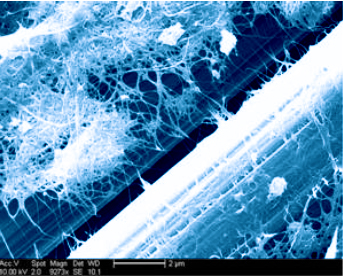
Engineers Want to Design Custom-Built Nanotubes to Reinforce Composite Materials
By:
- Ioana Patringenaru
Published Date
By:
- Ioana Patringenaru
Share This:
Article Content

The carbon nanotubes can be seen in the resin matrix, bonding to the carbon fibers. This image was taken using a Scanning Electron Microscope in the Nano3 research facility, at the University of California, San Diego. The two large fibers seen in the image are the carbon fibers which are nearly 20 times smaller than the average diameter of a human hair. The smaller strands connecting the adjacent carbon fibers are the nanotubes which are approximately 50,000 times smaller than the average diameter of a human hair.
Engineers at the University of California, San Diego are investigating how carbon nanotubes could reinforce the resin matrix found in composite materials commonly used in the aerospace, defense, automotive and sporting goods industries. The ultimate goal is to develop a custom-tailored nanoparticle to reinforce the resin matrix as well as developing a procedure to place these high-performance particles in critical stress regions.
The most widely used type of composite materials consists of layers of carbon fiber fabric held together by a resin matrix. The matrix is the materials’ weakest link—much weaker than the layers of fibers it binds. When composite structures fail due to compression or shear loading, it’s often because of this large discrepancy in strength between the fibers and the resin.
“Currently, UC San Diego is the only university that has investigated approaches that can be used in the high-volume automotive, civil, and sporting goods industry,” said John Kosmatka, a professor of structural engineering at the Jacobs School of Engineering.
The Composites and Aerospace Structures Laboratory has begun studying how the resin can be reinforced with nanotubes in conjunction with researchers from the UC San Diego Department of NanoEngineering.
Researchers have conducted a limited number of experimental tests. Preliminary results suggest that notable strength gains can be obtained by inserting the carbon nano-tubes into the resin. Due to the high cost of these carbon nano-tubes relative to the composite (carbon/epoxy) laminates, it is not practical to inject these carbon nano-tubes throughout the entire structure. Instead new fabrication approaches are being developed so that the carbon nanotubes are only inserted in critical stress regions. Different insertion techniques are being developed for the different composite industries based upon their fabrication approaches.
The lead researcher on the project is Ben Martins, a Ph.D. student at the Jacobs School, under the guidance of Kosmatka and Ken Vecchio, professor and chair of the NanoEngineering department at the Jacobs School. The project is in its early stages and will benefit from the opening of the Jacobs School’s new Structural and Materials Engineering Building, where both Kosmatka and Vecchio’s labs are located.
Share This:
You May Also Like
Stay in the Know
Keep up with all the latest from UC San Diego. Subscribe to the newsletter today.


